The Land Of China -- Explore by Province
Tibet
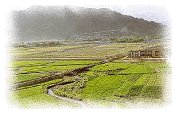 Tibet
Tibet
|
Tibet, one of five autonomous regions of China, is inhabited primarily by people of Tibetan ethnicity. The southwest border province of Tibet forms the southwestern portion of the Qinghai-Tibet Plateau and adjoins Xinjiang and the province of Qinghai to the north, Sichuan to the east, Yunnan to the southeast, and the nations of Burma (Myanmar), India, Bhutan, Sikkim and Nepal to the south and west along an international border of nearly 4,000 kilometers. The 1.22 million-square-kilometer autonomous region accounts for 12.8 percent of China's total land area.
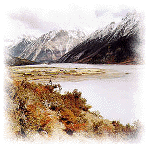 a Tibetan Valley
a Tibetan Valley
|
Averaging more than 4,000 meters in elevation, Tibet is well-known as the "roof of the world." While the topography is complex, the area can be divided into three distinct natural zones: the northern two thirds of the region, the North Tibet Plateau, is enclosed by the Kunlun, Tanggula, Gangdise, and Nyainqentanglha mountains; between the Gangdise Mountains and the Himalayas is the South Tibet Valley, where the Yarlungzangbo River and its tributaries flow; the east is an area of high mountains and deep valleys, part of the famous Hengduan Mountains, running first east-west then gradually shifting to north south. Geomorphologically, there are six principal forms: polar altitude mountains, alpine mountains, medium-height mountains, low mountains, hills and plains; volcanic, aeolian, karst and periglacial landforms are found as well.
 the Himalayas
the Himalayas
|
The Himalayas are a group of mountain ranges running roughly parallel to one another in an east-west direction on the southern edge of the Tibet Plateau along China's border with India and Nepal. The mountains run for 2,400 kilometers at a width of 200 to 300 kilometers and altitudes averaging over 6,000 metres. Mount Everest, the world's highest peak at 8848.13 meters, rises abruptly on the Sino-Nepalese border midway through the range. Four peaks over 8,000 metres high and 38 peaks over 7,000 metres can be found in the more than 5,000 square kilometres surrounding Everest.
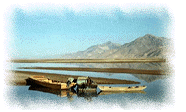 the Rivers of Tibet
the Rivers of Tibet
|
More than 120 rivers are found in Tibet, the best-known being the Jinsha, Nu, Lancang and Yarlungzangbo rivers. Tibet has more rivers flowing into foreign countries than any other Chinese province. These rivers, for the most part, arise from rains, melted ice and snow, and underground water, and hence their water is of excellent quality and flow rate high and siltage low. The Yarlungzangbo River, the largest in Tibet, has its source in a glacier at the northen foot of the Himalayas in Zhongba County. The 2,057-kilometer Chinese portion, with an approximate average altitude of 4,500 meters, is the world's highest-altitude river. The 370-kilometre Yarlungzangbo Gorge, at a depth of 5,382 meters, is the world's deepest. The vast Tibet Plateau is also bejewelled with more than 1,500 large and small lakes and is not only the area in China with the most dense concentration of lakes; in terms of number, area and altitude of lakes it leads all the world's plateaus.
 Tibet's Diverse Land
Tibet's Diverse Land
|
The Tibet Plateau's various complex topographies and landforms engender a distinctive climate. Beyond the general tendency of a cold, dry northwest and a warm, wet southeast can be found a wide variety of localized climates and distinct vertical climatic belts. The two sayings "different weather five kilometres apart" and "four seasons in one day" well describe this phenomenon. Daytime amd nighttime temperatures vary greatly, despite low average temperatures and low annual temperature differentials. Annual precipitation is 5,000 millimeters in the lower elevations in the southeast decreasing gradually to a mere 50 millimetres in the northwest.
 Religion in Tibet
Religion in Tibet
|
Tibet's unique culture, celebrated monasteries, and magnificent scenery make it charming and mysterious. Tibetans are nomads, or farmers raising barley, yak, and sheep. Different tribes wear dresses of distinctive style. In the seventh century, the king of Tubo, Songsten Gampo, married Wen Cheng, a Tang princess. The princess brought Chinese culture into Tibet. Religion is important in the life of Tibetans. The religion here is Lamaism, a sect of Buddhism that believes strongly in reincarnation and a torturous hell for sinners. Lamaism has many mystical elements. Lamaism is divided into two sects, the Yellow Hats and the Red Hats. Head of the Yellow Hats, the Dalai Lama, is believed to be the incarnation of God Chenrezi, and when each incarnation dies, his spirit takes on the body of another Tibetan child at birth. Another traditional Tibetan custom is giving Hada, a long silk scarf, as a token of esteem and good luck. Tibet has 50 monasteries open.
Lhasa, the capital of Tibet, is the political, economic, cultural, and communication and transportation center for the entire region. It has a recorded history of more than 1,300 years and is located on the northern hank in the middle reaches of the Lhasa River, a tributary of the Yarlungzangbo River. It is called the City of Sun because of its sufficient sunshine at an altitude of 3607 meters. The nearly-30,000-square-kilometer municipality is home to 400,000 people that includes Tibetans, Hans, Huis and other ethnic groups, with Tibetans accounting for 87 percent of the population.
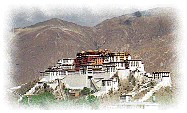 the Potala Palace
the Potala Palace
|
The Potala Palace perches on a lofty cliff, being 13-stories-high and containing 1000 rooms and 10,000 chapels and tombs of eight Dalai Lamas. It was built by Songsten Gampo and was the official residence of the Dalai Lama. From the 18th century, the palace was used only in the winter.
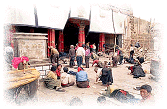 the Jokhang Temple
the Jokhang Temple
|
The Jokhang Temple, the most important Buddhist temple in Tibet, is in the heart of Lhasa. Princess Wen Cheng brought with her the seated statue of the child Sakyamuni. The Tibetans believe that the statue was made by Buddha himself. Here every year the Great Prayer Festival is held, when the temple is full of worshippers.
The Sera Monastery was built in 1419 and is one of the four major monasteries in Tibet. It contains 18 sandalwood arhats and four Heavenly Kings that were gifts from the Ming emperor. The Drepung Monastery, another one of the four major monasteries, was built in 1416. It has a white conch and a gildes Buddha. Norbulingka Park, once the summer residence of the Dalai Lama, is set in a 100-acre garden and has 370 rooms.
 Yak-Hair Tents
Yak-Hair Tents
|
Xigaze, a city 225 km west of Lhasa has the Tashilhunpo Monastery and is a very important religious city. It was founded in 1447 and was the home of the Panchen Lamas, the reincarnations of the Buddha of Eternal Light. The tenth Panchen Lama died here in 1989. Zhangmu is a place on the Tibet side of the Nepal border. Here, visitors are surrounded by a pastoral and forest setting and can live in yak-hair tents.



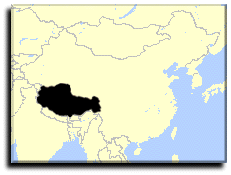
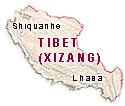












 Chinese Culture
Chinese Culture